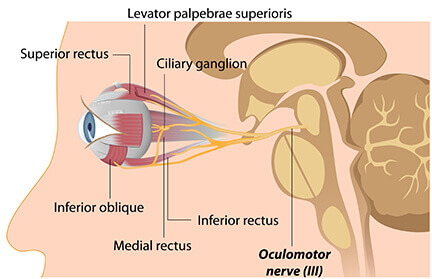 There are six muscles around each eye. These six muscles work together in an extremely sophisticated Oculomotor-Dysfunctionmanner in order to accurately control eye movements. Oculomotor Dysfunction occurs when these muscles are not properly coordinated. The causes of Oculomotor Dysfunction range from slow development to disease of the central nervous system. An eye exam easily diagnoses this condition.
There are six muscles around each eye. These six muscles work together in an extremely sophisticated Oculomotor-Dysfunctionmanner in order to accurately control eye movements. Oculomotor Dysfunction occurs when these muscles are not properly coordinated. The causes of Oculomotor Dysfunction range from slow development to disease of the central nervous system. An eye exam easily diagnoses this condition.
If one’s oculomotor muscles are ineffective, he may have difficulty reading–he may easily lose his place or repeat sentences. People with this condition may also have difficulty with balance, depth perception, sports, or hand eye coordination. Virtually every task requires good control of eye movements.
Eye movements essential to proper eye function include:
- Smooth Pursuits – the ability to stabilize gaze and follow a moving object with the eyes accurately;
- Saccades – the ability to jump your eyes from one target to another accurately. Saccades are necessary for tracking skills while reading or copying information. In order to process visual information properly, the eyes must move smoothly and quickly from one object to another. Saccades are crucial to the ability of the visual system to perceive and interpret images. When smoothly tracking with the eyes, the eyes must also be able to cross the midline of the body without hesitation;
- Convergence/Divergence – the ability of the eyes to move inward/outward in order to focus on an object as it moves near/far. To look at an object close up, the eyes rotate towards each other (convergence), while for an object farther away they rotate away from each other (divergence). These movements are crucial for near point gaze shifting, such as reading, and for far point gaze shifting, such as copying from the board.
Symptoms
If your child is having a hard time consciously controlling the movements of his eye or eyes, some of the resulting signs and symptoms can appear:
- Increased activity level
- Difficulty with visual attention
- Decreased visual perception
- Poor visual attention to detail
- Poor visual memory
- Difficulties copying from his paper or from the board to his paper
- Difficulties concentrating and maintaining attention on school work/an activity (i.e. drawing, coloring, cutting, puzzles, reading, writing, etc.) in front of him
- Difficulties scanning when trying to find objects in competing backgrounds (i.e. finding his shoes in a messy room).
- Reduced efficiency and/or productivity
- Loss of place, repetition, and/or omission of words and/or lines of print while reading
- Spatial disorientation
- Need to utilize a marker in order to avoid loss of place
- Distractibility while performing visually demanding tasks
- Diminished accuracy
- Difficulty sustaining near visual function
- General fatigue
- Abnormal postural adaptation/abnormal working distance
- Incoordination/clumsiness
- Inaccurate/inconsistent/poor work product
- Inaccurate eye-hand coordination
Our Approach
When oculomotor control issues are detected our optometrist perform definitive testing and create a prescribed treatment plan for improving ocular skills. We then design a specific treatment regimen which not only alleviates symptoms, but addresses any underlying conditions that may exist. Oculomotor dysfunction is most often due to a faulty development of muscle control, so a program of coordinating or strengthening activities is prescribed in a vision therapy program. Many ocular motor dysfunctions require optometric vision therapy/orthoptics to develop accurate and effective eye teaming, as this condition rarely resolves when left untreated. Treatment duration depends on the particular patient’s condition. At the conclusion of the active treatment regimen, periodic follow-up evaluations are required. We may even prescribe therapeutic lenses to assist in maintaining long-term stability.


